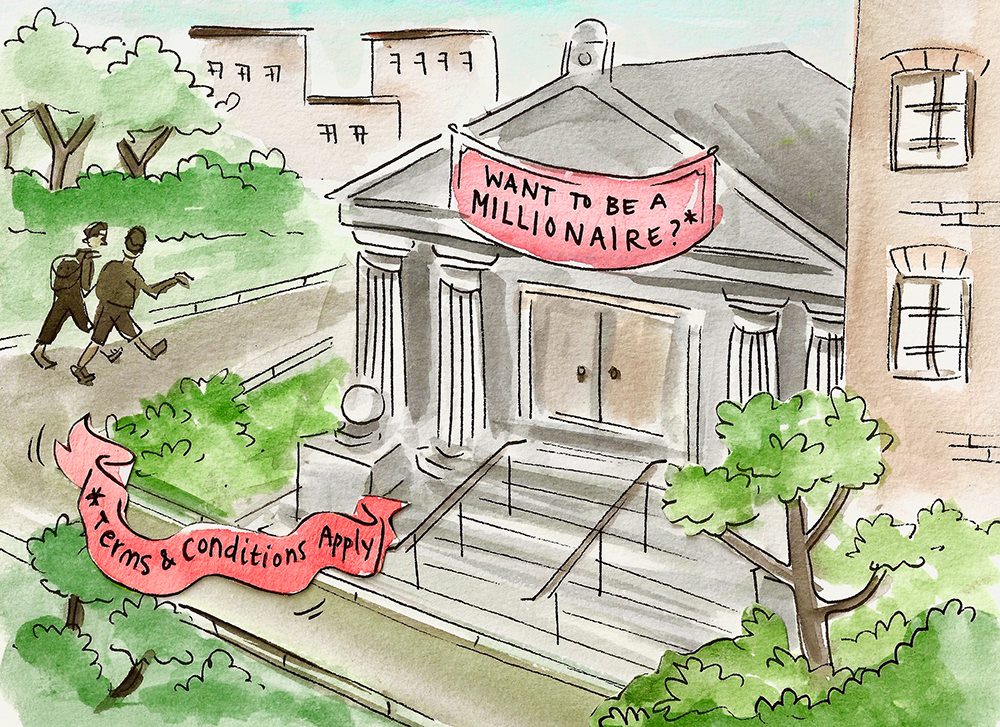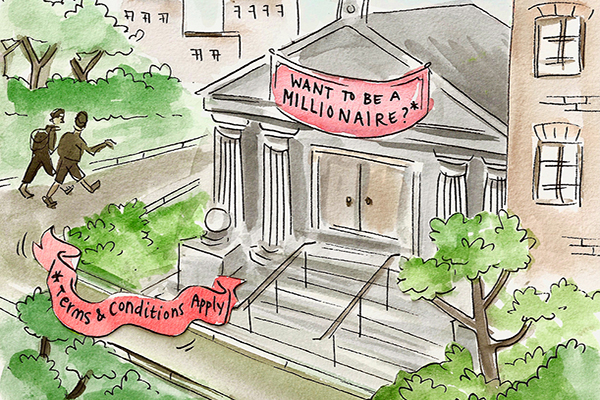On the first day of the Democratic National Committee we heard Bernie talk about how the new Democratic platform will allow children in any family making less than $125,000 a year to go to a public college or university tuition free, while substantially reducing student debt. This is a big win for the platform, and evidence that Bernie forced Hillary left.
Meanwhile, Obama’s Council of Economic Advisors released a report arguing that the $1.3 trillion in student debt is helping, not hurting, the US economy. They argue it is helping relative to a baseline where people would not attend college if not given access to loans to get there. They come to this conclusion using lifetime earnings models to show that on average someone with a bachelor’s degree makes $1 million more than someone without it. This then outweighs the costs of their student debt. If student debt levels rose to $500,000 for a college education, however, their argument still holds.
The thing is, the economy would be doing even better without the massive debt burden placed on our young people. As Nick Cassella of Civic Skunk Works argues, framing education like they do reveals their preference to view a college education as an investment rather than a right. It also frames a four year bachelor’s degree as “the” college education, rather than helping students to understand all the options available. As sociologist James Rosenbaum highlights, high schools and community colleges encourage almost exclusively four year bachelor degree programs to their students. This downplays important certifications and associate’s degrees. If a bachelor’s degree is a right, a public investment we believe all citizens should have, then it should be available for free without debt. If it is merely an individual investment, than it should not be promoted as the solution for everyone. The highest volume of in demand jobs today do not require a four year bachelor’s degree.

The interplay of education and job access highlights the two, sometimes not overlapping, goals of higher education housed into one institution: educating our population, and training our workforce. This has been an institutional feature of the American system for some time, noted by socio-economist Thorstein Veblen in his 1918 piece The Higher Learning in America. William Deresiewicz, in his book Excellent Sheep, recounts his time at Yale and the stories he saw of youth conflicted between these two goals. Students are taught to be active engaged citizens, which for some would involve teaching and public service, yet careers on Wall Street and in big private sector firms are the ones that allow them to payoff their debts faster and make college “worth it”. Framing college as an investment discounts the true value of an education. Pushing students to take on debt to get their degrees also forces this view of college as a monetary investment rather than an investment in education. Even when it is framed as an investment, it does not payoff the same for everyone. While averaging across all bachelor’s degrees you get a million dollar payoff, those lifetime earnings are not distributed equally among all graduates. Using the 2014 ACS, I calculate that the average income of a white person with a bachelor’s degree is $63,000 versus $48,000 for a black person. The St. Louis Fed shows that racial wealth gaps still exist despite college degrees. Even the CEA report says “ten percent of workers age 35 to 44 with a bachelor’s degree had earnings under $20,000, compared to 25 percent of workers with only a high school diploma.” As an investment then, it pays off the most for those who can already afford it.
If the goal of the university system is to educate our population, then it should be a right for everyone. John Adams said that “the whole people must take upon themselves the education of the whole people, and must be willing to bear the expense of it.” If our definition of educated continues to mean a four year bachelor’s degree, we must bear that public expense and not put it on students through debt. However, if we can accept educated to be at a high school level, then we can stop the college for all rhetoric and help students better understand the demand side of the economy. For every 2 jobs that require a bachelor’s degree, there are 7 that require a certification. FRED shows 5.5 million job openings today in America. Close to a million are in healthcare and social assistance, half a million are in manufacturing and construction, and around 760,000 are in the leisure and hospitality industry. Most jobs in these industries only require associate’s degrees, certifications, or high-school educations with on the job training. These are good jobs. We need social workers, nurses, plumbers and electricians, and these jobs do not require four year bachelor’s degrees. As Rosenbaum argues “the real goal should not be the unrealistic vision of everyone becoming a doctor, but rather the elimination of the all too common outcome of youths facing dead-end jobs and unemployment as their only options.” Yet 5.5 million job openings does not come close to the over 17 million unemployed according to official unemployment numbers. When there just aren’t enough jobs to go around, we should not be encouraging our citizens to take on high levels of student debt.
Rather than suggesting workers take on debt to be “trained” for the workforce, we should focus on creating jobs that pay workers to learn valuable skills. As Minsky said, “it has never been shown that a thorough program of job creation, taking people as they are, will not, by itself, eliminate a large part of the poverty that exists.” A bachelor’s degree is not a blanket guarantee to a better life, so if we believe in having a more educated population it should be a right as the Democrats are now arguing for. If it is purely meant to be thought of as a monetary investment in training yourself for the workforce, then by looking at the demand side we see that it is clearly not for everyone. John Adams said that “laws for the liberal education of youth, especially of the lower class of people, are so extremely wise and useful, that, to a humane and generous mind, no expense for this purpose would be thought extravagant.” This education need not be a four year bachelor’s degree, but I think it should be. As it is today, we need to make sure young people are aware of all the options available in the economy, and only straddle themselves with debt if they truly will benefit from it. Getting rid of student debt for public bachelor’s degrees allows us all to benefit from having a more educated population. Without large amounts of debt to worry about, student’s can focus on learning for four more years. We have the rest of our lives to work.
Written by Bradley Voracek
Illustration by Heske van Doornen




 In order for households to get enough deposits so they can pay back their debts, the government should run deficits that end up in their hands. The reliance on the private sector has taken priority over the public good, and most of the deposits have landed in the hands of the top 1%. They were supposed to “
In order for households to get enough deposits so they can pay back their debts, the government should run deficits that end up in their hands. The reliance on the private sector has taken priority over the public good, and most of the deposits have landed in the hands of the top 1%. They were supposed to “